Publications - Journal Publications
Publication Types:

Surface texture modulation via buckling in porous inclined mechanical metamaterials
doi:10.1016/j.eml.2021.101549
Abstract
Porous materials with well-defined periodicity are commonly encountered in biological and synthetic structures and exhibit a wide range of behaviors, ranging from negative Poisson’s ratios, to high energy absorption and acoustic damping. Recently, the response of these systems has been shown to be enhanced by mechanical instabilities that lead to sudden and reversible geometric transformations. Although buckling induces planar transformations in most of 2D porous metematerials, here we describe the emergence of 3D morphologies triggered by mechanical instabilities in an elastomeric block with tilted cylindrical holes. As a proof of concept, we demonstrate that these structures can be leveraged to tune surface properties including friction and light reflection, thus providing a new experimental platform for investigating deformation-dependent dynamics for tribological and optical applications.
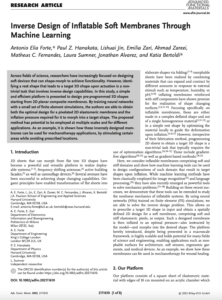
Inverse design of inflatable soft membranes through machine learning
doi:10.1002/adfm.202111610
Abstract
Across fields of science, researchers have increasingly focused on designing soft devices that can shape-morph to achieve functionality. However, identifying a rest shape that leads to a target 3D shape upon actuation is a non-trivial task that involves inverse design capabilities. In this study we present a simple and efficient platform to design pre-programmed 3D shapes starting from two-dimensional planar composite membranes. By training Neural Networks with a small set of finite element simulations, we were able to obtain both the optimal design for a pixelated 2D elastomeric membrane and the inflation pressure required for it to morph into a target shape. The proposed method has potential to be employed at multiple scales and for different applications. As an example, we show how these inversely designed membranes can be used for mechanotherapy applications, by stimulating certain areas whilst avoiding prescribed locations.
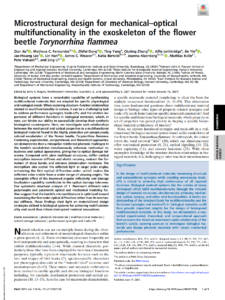
Microstructural design for mechanical–optical multifunctionality in the exoskeleton of the flower beetle Torynorrhina flammea
doi:10.1073/pnas.2101017118
Abstract
Biological systems have a remarkable capability of synthesizing multifunctional materials that are adapted for specific physiological and ecological needs. When exploring structure–function relationships related to multifunctionality in nature, it can be a challenging task to address performance synergies, trade-offs, and the relative importance of different functions in biological materials, which, in turn, can hinder our ability to successfully develop their synthetic bioinspired counterparts. Here, we investigate such relationships between the mechanical and optical properties in a multifunctional biological material found in the highly protective yet conspicuously colored exoskeleton of the flower beetle, Torynorrhina flammea. Combining experimental, computational, and theoretical approaches, we demonstrate that a micropillar-reinforced photonic multilayer in the beetle’s exoskeleton simultaneously enhances mechanical robustness and optical appearance, giving rise to optical damage tolerance. Compared with plain multilayer structures, stiffer vertical micropillars increase stiffness and elastic recovery, restrain the formation of shear bands, and enhance delamination resistance. The micropillars also scatter the reflected light at larger polar angles, enhancing the first optical diffraction order, which makes the reflected color visible from a wider range of viewing angles. The synergistic effect of the improved angular reflectivity and damage localization capability contributes to the optical damage tolerance. Our systematic structural analysis of T. flammea’s different color polymorphs and parametric optical and mechanical modeling further suggest that the beetle’s microarchitecture is optimized toward maximizing the first-order optical diffraction rather than its mechanical stiffness. These findings shed light on material-level design strategies utilized in biological systems for achieving multifunctionality and could thus inform bioinspired material innovations.
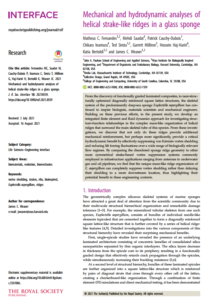
Mechanical and hydrodynamic analyses of helical strake-like ridges in a glass sponge
doi:10.1098/rsif.2021.0559
Abstract
From the discovery of functionally graded laminated composites, to near-structurally optimized diagonally reinforced square lattice structures, the skeletal system of the predominantly deep-sea sponge Euplectella aspergillum has continued to inspire biologists, materials scientists and mechanical engineers. Building on these previous efforts, in the present study, we develop an integrated finite element and fluid dynamics approach for investigating structure–function relationships in the complex maze-like organization of helical ridges that surround the main skeletal tube of this species. From these investigations, we discover that not only do these ridges provide additional mechanical reinforcement, but perhaps more significantly, provide a critical hydrodynamic benefit by effectively suppressing von Kármán vortex shedding and reducing lift forcing fluctuations over a wide range of biologically relevant flow regimes. By comparing the disordered sponge ridge geometry to other more symmetrical strake-based vortex suppression systems commonly employed in infrastructure applications ranging from antennas to underwater gas and oil pipelines, we find that the unique maze-like ridge organization of E. aspergillum can completely suppress vortex shedding rather than delaying their shedding to a more downstream location, thus highlighting their potential benefit in these engineering contexts.
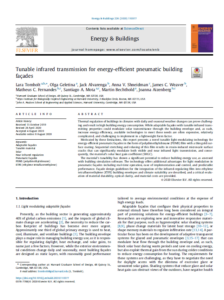
Tunable infrared transmission for energy efficient pneumatic building façades
doi:10.1016/j.enbuild.2020.110377
Abstract
Thermal regulation of buildings in climates with daily and seasonal weather changes can prove challenging and result in high building energy consumption. While adaptable façades with tunable infrared transmitting properties could modulate solar transmittance through the building envelope and, as such, increase energy efficiency, available technologies to meet these needs are often expensive, relatively complicated, and challenging to implement in a lightweight form factor.
Motivated by these limitations, this report presents a novel tunable light-modulating technology for energy-efficient pneumatic façades in the form of polydimethylsiloxane (PDMS) film with a thin gold surface coating. Sequential stretching and relaxing of this film results in strain-induced microscale surface cracks that can significantly modulate both visible and near infrared light transmission, and consequently, the material’s solar heat gain coefficient (SHGC).
The material’s tunability has shown a significant potential to reduce building energy use, as assessed with building simulation software. The technology offers additional advantages for light modulation in pneumatic façades including real-time operation, ease of implementation and control, and predictable performance. Façade design guidelines for the integration of the infrared-regulating film into ethylene tetrafluoroethylene (ETFE) building envelopes and climate suitability are described, and a critical evaluation of material durability, optical clarity, and material costs are provided.
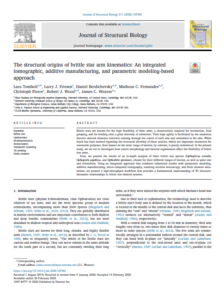
The structural origins of brittle star arm kinematics: An integrated tomographic, additive manufacturing, and parametric modeling-based approach
doi:10.1016/j.jsb.2020.107481
Abstract
Brittle stars are known for the high flexibility of their arms, a characteristic required for locomotion, food grasping, and for holding onto a great diversity of substrates. Their high agility is facilitated by the numerous discrete skeletal elements (ossicles) running through the center of each arm and embedded in the skin. While much has been learned regarding the structural diversity of these ossicles, which are important characters for taxonomic purposes, their impact on the arms’ range of motion, by contrast, is poorly understood. In the present study, we set out to investigate how ossicle morphology and skeletal organization affect the flexibility of brittle star arms. Here, we present the results of an in-depth analysis of three brittle star species (Ophioplocus esmarki, Ophiopteris papillosa, and Ophiothrix spiculata), chosen for their different ranges of motion, as well as spine size and orientation. Using an integrated approach that combines behavioral studies with parametric modeling, additive manufacturing, micro-computed tomography, scanning electron microscopy, and finite element simulations, we present a high-throughput workflow that provides a fundamental understanding of 3D structurekinematic relationships in brittle star skeletal systems.

Mechanically Robust Lattices Inspired By Deep-Sea Glass Sponges
doi:10.1038/s41563-020-0798-1
Abstract
The predominantly deep-sea hexactinellid sponges are known for their ability to construct remarkably complex skeletons from amorphous hydrated silica. The skeletal system from one such example, Euplectella aspergillum, consists of a square-grid-like architecture overlaid with a double set of diagonal bracings, creating a checkerboard-like pattern of open and closed cells. Here, using a combination of finite element simulations and mechanical tests on 3D-printed specimens of different lattice geometries, we show that the sponge's diagonal reinforcement strategy achieves the highest buckling resistance for a given amount of material. Furthermore, using an evolutionary optimization algorithm, we show that our sponge-inspired lattice geometry occurs near the design space's material distribution optimum. Our results demonstrate that lessons learned from the study of sponge skeletal systems can be exploited for the realization of square lattice geometries that are geometrically optimized to avoid global structural buckling, with implications for improved material use in modern infrastructural applications.

A geometrically adaptable heart valve replacement
doi:10.1126/scitranslmed.aay4006
Abstract
Congenital heart valve disease has life-threatening consequences that warrant early valve replacement; however, the development of a growth-accommodating prosthetic valve has remained elusive. Thousands of children continue to face multiple high-risk open-heart operations to replace valves that they have outgrown. Here, we demonstrate a biomimetic prosthetic valve that is geometrically adaptable to accommodate somatic growth and structural asymmetries within the heart. Inspired by the human venous valve, whose geometry is optimized to preserve functionality across a wide range of constantly varying volume loads and diameters, our balloon-expandable synthetic bileaflet valve analog exhibits similar adaptability to dimensional and shape changes. Benchtop and acute in vivo experiments validated design functionality, and in vivo survival studies in growing sheep demonstrated that mechanical valve expansion accommodated growth. As illustrated in this work, dynamic size adaptability with preservation of unidirectional flow in prosthetic valves thus offers a paradigm shift in the treatment of heart valve disease.
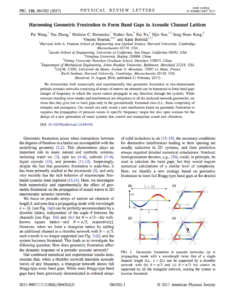
Harnessing Geometric Frustration to Form Band Gaps in Acoustic Networks
doi:10.1103/PhysRevLett.118.084302
Abstract
We demonstrate both numerically and experimentally that geometric frustration in two-dimensional periodic acoustic networks consisting of arrays of narrow air channels can be harnessed to form band gaps (ranges of frequency in which the waves cannot propagate in any direction through the system). While resonant standing wave modes and interferences are ubiquitous in all the analyzed network geometries, we show that they give rise to band gaps only in the geometrically frustrated ones (i.e. those comprising of triangles and pentagons). Our results not only reveal a new mechanism based on geometric frustration to suppress the propagation of pressure waves in specific frequency ranges, but also opens avenues for the design of a new generation of smart systems that control and manipulate sound and vibrations.
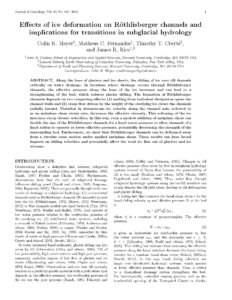
Effects of Ice Deformation on Röthlisberger Channels and Implications for Transitions in Subglacial Hydrology
doi:10.1017/jog.2016.65
Abstract
Along the base of glaciers and ice sheets, the sliding of ice over till depends critically on water drainage. In locations where drainage occurs through Röthlisberger channels, the effective pressure along the base of the ice increases and can lead to a strengthening of the bed, which reduces glacier sliding. The formation of Röthlisberger channels depends on two competing effects: (1) melting from turbulent dissipation opens the channel walls and (2) creep flow driven by the weight of the overlying ice closes the channels radially inward. Variation in downstream ice velocity along the channel axis, referred to as an antiplane shear strain rate, decreases the effective viscosity. This softening of the ice increases creep closure velocities. In this way, even a modest addition of antiplane shear can double the size of the Röthlisberger channels for a fixed water pressure or allow channels of a fixed radius to operate at lower effective pressure, potentially decreasing the strength of the surrounding bed. Furthermore, we show that Röthlisberger channels can be deformed away from a circular cross section under applied antiplane shear. These results can have broad impacts on sliding velocities and potentially affect the total ice flux out of glaciers and ice streams.
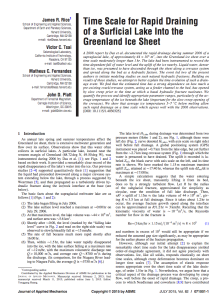
Time Scale for Rapid Drainage of a Surficial Lake into the Greenland Ice Sheet
doi:10.1115/1.4030325
Abstract
A 2008 report by Das et al. documented the rapid drainage during summer 2006 of a supraglacial lake, of approximately  , into the Greenland ice sheet over a time scale moderately longer than 1 hr. The lake had been instrumented to record the time-dependent fall of water level and the uplift of the ice nearby. Liquid water, denser than ice, was presumed to have descended through the sheet along a crevasse system and spread along the bed as a hydraulic facture. The event led two of the present authors to initiate modeling studies on such natural hydraulic fractures. Building on results of those studies, we attempt to better explain the time evolution of such a drainage event. We find that the estimated time has a strong dependence on how much a pre-existing crack/crevasse system, acting as a feeder channel to the bed, has opened by slow creep prior to the time at which a basal hydraulic fracture nucleates. We quantify the process and identify appropriate parameter ranges, particularly of the average temperature of the ice beneath the lake (important for the slow creep opening of the crevasse). We show that average ice temperatures 5–7
, into the Greenland ice sheet over a time scale moderately longer than 1 hr. The lake had been instrumented to record the time-dependent fall of water level and the uplift of the ice nearby. Liquid water, denser than ice, was presumed to have descended through the sheet along a crevasse system and spread along the bed as a hydraulic facture. The event led two of the present authors to initiate modeling studies on such natural hydraulic fractures. Building on results of those studies, we attempt to better explain the time evolution of such a drainage event. We find that the estimated time has a strong dependence on how much a pre-existing crack/crevasse system, acting as a feeder channel to the bed, has opened by slow creep prior to the time at which a basal hydraulic fracture nucleates. We quantify the process and identify appropriate parameter ranges, particularly of the average temperature of the ice beneath the lake (important for the slow creep opening of the crevasse). We show that average ice temperatures 5–7  below melting allow such rapid drainage on a time scale which agrees well with the 2006 observations.
below melting allow such rapid drainage on a time scale which agrees well with the 2006 observations.
